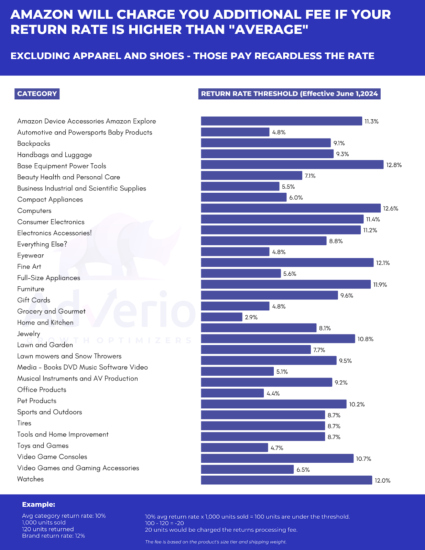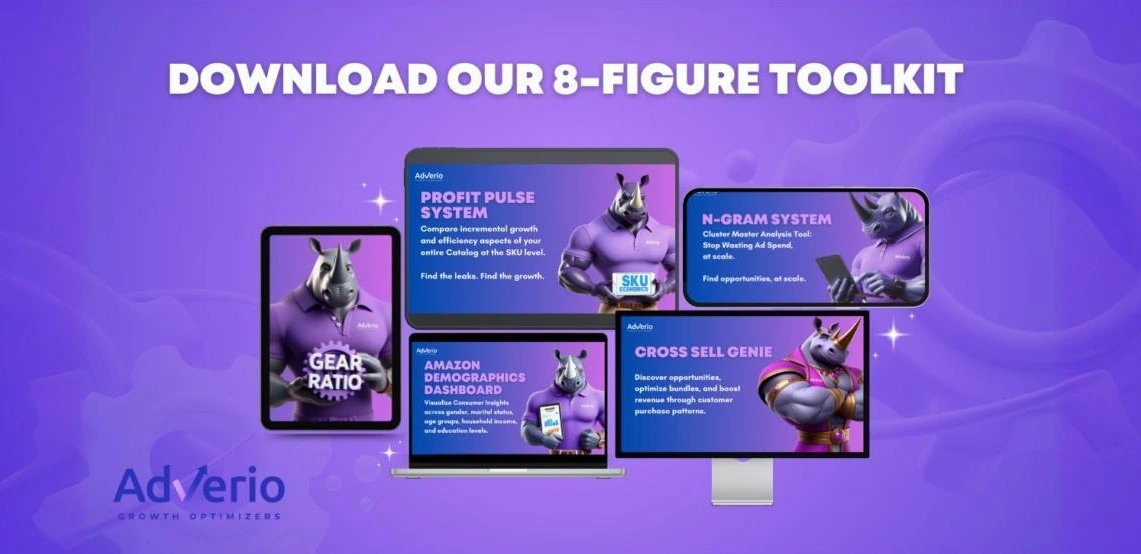Returns. Overstock. Unsellable. They’re the silent killers of marketplace profit, and most brands don’t talk about them until it’s too late.
At scale, returns are a guarantee. Whether you’re moving hundreds or thousands of units per week, 5–15% of it will come back. If you’re not actively managing how those units are handled, stored, or liquidated, you’re not just losing sales, you’re compounding fees, capping restock limits, and missing a hidden revenue stream.
The good news?
Amazon now offers a suite of tools that allow smart operators to recover value, reduce fees, and monetize what others throw away, but most brands are either underutilizing them or not using them at all.
This isn’t just about operations. It’s a margin play.
The Real Cost of Ignoring Returns
Here’s what’s really happening inside most under-optimized catalogs:
Returned inventory gets marked as unsellable
Unsellable sit in FBA longer than they should
Brands pay recurring storage and removal fees
Meanwhile, cash is tied up in inventory that isn’t moving, can’t be resold, and hasn’t been written down
The longer you let that cycle run, the more you’re penalized with:
Higher long-term storage fees
Restock limit compression
Lower IPI scores
Capital inefficiency across your P&L
And in a marketplace where cash turns and contribution margin drive growth, not just top-line revenue that’s a dangerous blind spot.

How Smart Operators Recover Value (Without Gutting Margins)
Amazon offers a full menu of value-recovery programs—but most sellers only use one (maybe two), and few track ROI across them. Here’s how your brand can do better:
FBA Liquidations: Get Paid Instead of Paying to Remove
What it is:
A program that lets you sell off excess or returned inventory to Amazon’s liquidator network. Instead of removing items and paying disposal fees, you get a gross recovery value of 5–10% of your ASP.
Why it matters:
Liquidation protects your margin floor. For aging or dead SKUs, it’s often more profitable to recoup pennies on the dollar than to absorb months of storage and carry costs.
Best for:
- Excess FBA inventory
- Customer returns you can’t relist
- End-of-life SKUs
📊 Pro insight: A single liquidation batch of 3,000 units at $30 ASP could recover $4,500–$9,000 in net value—versus paying $1,000+ in removal and disposal fees.
Amazon Outlet: Deal-Based Sell-Through Without Branding Risk
What it is:
Amazon’s clearance platform for excess inventory. You can discount items and feature them on a dedicated Outlet page, often generating a surge in visibility and sessions.
Why it works:
Outlet deals are pre-approved by Amazon and help move inventory faster, reduce storage overhead, and improve IPI and restock eligibility.
Best for:
- Stale inventory that still has resale potential
- Seasonal overstock
- SKUs with stable listings but slowing velocity
💡 Tip: Unlike price-cutting in your primary PDP, Outlet deals isolate the discount—protecting your core offer and maintaining pricing integrity across other channels.
FBA Refurbishment & Repackaging: Restore Value from Cosmetic Damage
What it is:
Amazon’s internal team will repair and repackage eligible returned items. That includes reboxing, removing labels, resealing damaged packaging—even steaming and deodorizing apparel.
Why it matters:
Many “unsellable” returns are still in working condition. With refurbishment, you can recover full ASP or near full, instead of paying to dispose of functional items.
Best for:
- Consumer electronics
- Apparel
- Beauty
- Home goods
📊 A typical brand can recover $15–25 per unit on refurbished goods vs $0 through disposal.
FBA Grade and Resell: Monetize Unsellable as “Used” Listings
What it is:
An invite-only program that lets you relist returned goods in “Used – Good” or “Acceptable” condition. Amazon grades the product and creates a listing—you set the price and control the inventory.
Why it’s powerful:
It creates a second sales path for unsellable, protecting your ASP and allowing you to turn dead inventory into profitable velocity.
Best for:
Items that can’t be sold new but still function
Products with light wear or open-box condition
SKUs with strong organic demand, even used
Important: Processing fees apply only if the product is successfully relisted—no cost for items deemed unsellable.
FBA Donations Program: Turn Write-Offs into Impact (and Avoid Disposal Fees)
What it is:
Amazon will donate your unwanted inventory to registered US charities. You’re automatically enrolled, and eligible disposals are flagged for donation before removal.
Why it works:
Instead of eating full disposal fees and seeing zero return, you can align with a CSR initiative, protect your brand image, and still avoid long-term FBA charges.
Best for:
- Obsolete or non-relistable inventory
- Low ASP items
- Inventory write-offs tied to Q4 or promotional volume
Tax insight: You may qualify for charitable deductions (consult your tax advisor).
Bonus: Automate Value Recovery with Amazon’s New Settings
If your team isn’t already using Amazon’s Automated Value Recovery Settings, now’s the time.
You can now configure a full, prioritized flow that tells Amazon what to do with your unsellable inventory without touching a case log or micromanaging every SKU.
Here’s how it works:
You set your preferences under:
Seller Central → FBA Settings → Value Recovery Options
Then Amazon automatically routes unsellable inventory through the following recovery path:
- Refurbishment (if eligible)
- Grade and Resell
- Liquidations
- Return or Dispose
You control which categories or ASINs are eligible for each step, and you can exclude SKUs from any program.
Key Benefits:
- No more manual decision fatigue. You define the rules once—Amazon executes at scale.
- Recover value automatically. Every return is routed toward the highest possible value outcome.
- Preserve cash flow without tying up headcount. No more daily emails to decide what to relist, liquidate, or donate.
You can even pre-set pricing for Grade and Resell SKUs, which get auto-listed as “Used – Good” once Amazon evaluates their condition.
Enable Returnless Resolution Rules for Low-Cost SKUs
Alongside this, Amazon also lets you create Returnless Resolution Rules.
Found in: Seller Central → Return Settings → Resolutions
This allows you to auto-refund buyers for specific products without requiring the return. It’s ideal for:
- Low-cost SKUs
- Easily damaged goods
- High-return-rate categories like beauty, apparel, or CPG
The benefits:
- Avoids added return processing costs
- Speeds up refund time, improving CX
- Prevents “unsellables” from ever re-entering your supply chain
Set returnless logic by SKU, category, or price threshold.
Strategic Takeaway: Recovery Systems Aren’t Optional Anymore
Managing thousands of units across marketplaces means one thing: returns will happen. The real question is—are you recovering value, or just absorbing loss?
Manual processes can’t keep up. Case-by-case decisions don’t scale.
And every delay, disposal, or missed resale is margin quietly walking out the door.
Top operators treat return management like performance marketing—data-driven, automated, and profit-focused.
What Growth-Driven Brands Are Doing Differently:
- Automating value recovery flows using Amazon’s built-in tools
- Segmenting SKUs by resale potential—refurbish, relist, liquidate, or donate
- Enabling returnless refunds for low-value items to cut reverse logistics
- Reviewing SKU-level return patterns to diagnose PDP gaps and QC issues
- Measuring recovery ROI and using it to fund ad scale or restock key SKUs
This isn’t about damage control. It’s a high-leverage profitability system—and it’s being ignored by most of your competitors.
Final Word
You’re not just losing money on returns.
You’re funding fees, draining storage, and freezing capital that could be deployed elsewhere.
The brands we work with are recovering 5–10% of ASP on dead stock, relisting “unsellables” with Grade & Resell, and routing thousands of units through automated flows—with no additional headcount.
This is the kind of operational edge that protects your bottom line when ad costs climb and growth gets harder.
Let us show you what that looks like in your business. Book a Simplify & Scale Session.





























